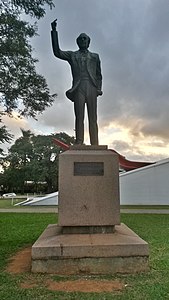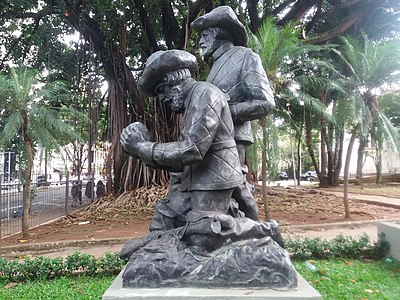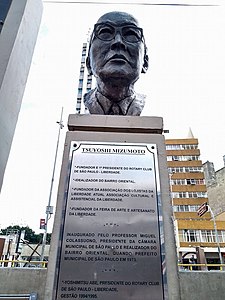Education loves Monuments: A Brazilian Tale
editAuthor: Joalpe

Summary:Communications students document and investigate the presence of monuments and sculptures in São Paulo
Monuments carry, simultaneously, an expression of the past, of a time that is no more, and an omen of what our time and the future will pay attention to. It is the tip of a city layer that might have ceased to exist, in an evolving urban system of rapid transformations. It is an object of culture that often also signifies episodes of violence; or, as philosopher Walter Benjamin put it, a reminder of the power of the powerful and the attempt to render invisible those who are seen as powerless.
Monuments are also a reference point of urban space and local politics. They are an element in the realm of possible social dynamics at play in squares, avenues, parks. They provide us of an evidence of the investment of governments in public spaces. In the context of Brazil, where I am writing from, monuments carry the marks of our unequal society.
The topics in the paragraphs above --summarized herein-- have informed several sections with Communications students at Faculdade Cásper Líbero. The theoretical goal was to make sense of cultural legacy and power dynamics in the process of writing what is notorious and worth remembering. The practical activity was to document and comment monuments and sculptures in São Paulo city, and improve content on Wikidata and Wikimedia Commons.

Each student received a photographic task, normally to develop a set of images of one or two objects in São Paulo that were recognized as being monuments or sculptures by the city government. There are around 1,100 of those objects in São Paulo; around 200 are either destroyed or missing. Instructions were provided during the sections by myself and often by an experienced Wikimedia Commons contributor, Rodrigo Tetsuo Argenton. Students often set up pairs or groups to work on their assignment.
In 2018, I expect this education program to have covered 650 monuments and sculptures in São Paulo. Outreach Dashboard reports are: 2016, 2017, 2018-1, and 2018-2 (ongoing). The general Commons category is: Projeto_Commons_da_Faculdade_Cásper_Líbero (not all specific program is associated to documenting monuments on this category). So far, around 7,000 images were uploaded to the project --in most cases, no image of the monument existed on the project before the student documented it.
Students also improved information on Wikidata associated to the item on monuments and sculptures in São Paulo. Items already existed, as with Ederporto and other Brazilian Wikimedians, we had worked on scrapping the official database of the city government. Yet, some pieces of information --i.e., geocoordinates, inscriptions-- were often missing and were contributed by students; moreover, and of course, as students uploaded images to Commons they were used to illustrate the Wikidata element and a Commons category link was established. A dynamically updated control of these contributions can be found on a Listeria-generated page I have put up: São Paulo monument log.
For students, the expectation is that they are able to get to know more about their city, not only going to places they had never been to --as monuments were randomly assigned, and students often had to cross the whole city to get to them-- but also look more critically to what power dynamics are at play to what is being preserved, what has disappeared, what politics wants us to perceive as notorious and what is just being kept out of the record. For instance, questions that were systematically made by students themselves as they looked at reality: Why are there almost no women depicted in monuments and sculptures? Why are there almost no African Brazilians in monuments and sculptures? Why are there monuments and sculptures of slave owners and military dictators? --the latter followed by: Why don't we just put them down?
-
O Jornaleiro
-
Vicente Matheus
-
Diálogo
-
Dom Luiz Orione
-
Ibrahim Nobre
-
Gato
-
Infante Dom Henrique
-
Estrela Cadente
-
Mãe
-
Washington Pelucio
-
Colhedor de Café
-
Túlio Fontoura
-
Moraes Sarmento
-
O caçador de esmeralda
-
Ramos de Azevedo
-
Tsuyoshi Mizumoto
Tags: Brazil, monuments, communications, university















